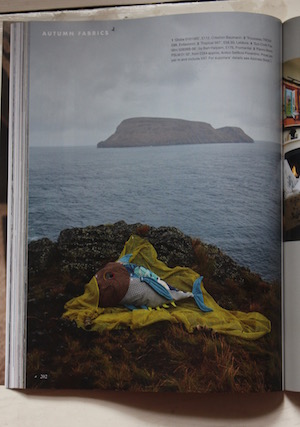
I am hardly ever proud of what I have done. I follow a curve of getting very excited about something and then thinking it’s a pile of rubbish. I am with all those artists who say that there is massive frustration in what is in your imagination or mind’s eye and what you are actually able to achieve. But, for once, I am absolutely delighted with this piece, an embroidered fabric collage of some sort of bird.
I started this piece on a lovely weekend at the wonderful Shore Cottage Studios on the Wirral. I have written a lot about this magical place on my blog before. This time I went with my Grate Frend, Mike, who is a brilliant maker of fabric collage, and who I thought would like the studio and Sue, who was our tutor, and fabric dyeing (all of which he did). We went for a walk on the beach and gathered some inspirational stuff: stones, feathers, crab shell, seaweed and so on. Then we did some drawing and in the afternoon some microwave and rust dyeing. The following day we started to make our pieces.
I found all this so exciting that I couldn’t sleep on the first night, so I did some sketchbook work and got prepared for the following day. This is my sketch of what I intended to make:

It’s a pretty wreath with all those elements we found on the beach. I went on to work out all the stitches I would use, and was ready to go.
In my hotel room, however, was a copy of House and Garden, which I very seldom read as the houses really are grand, and my house is not. But it had a picture from an exhibition at Waddeston Manor:

I thought he was rather magnificent, although rather more striking than pheasants I have encountered. Anyway, I ummed and ahhed, but finally decided to make a pheasant rather than a wreath. I used the fabric that I had dyed the previous day and supplemented it with a bit from Sue’s stash, and in the bottom right hand corner a pale turquoise piece that Mike had dyed. I very carefully hand-appliquéd a rosy red piece for the body using the needle-turning technique. Bit of a daft mistake. No-one can now see my exquisite (!!!!!) hand appliqué and it meant another layer to stitch through, and it was thick by the end as much of what I used was weighty furnishing fabric.
It is one of my new-found pleasures of retirement that I was able to take it home and work on it the following day. Here are some details of the feathers:

I hope you can see from this photo that I over-dyed some printed fabric – you can see the white lines of the botanical design. I stitched into that with some of the hand-dyed threads we produced.

This shows the next layer of feathers which were stitched with a variety of threads, some commercial and some from the workshop. This was the first stitching and really brought the piece to life and convinced me to keep working into it.

These are the same feathers showing how the embroidery secures them but also allows them a 3D effect. It also shows some of the fraying I did on the feathers’ edges. My fingernails did not thank me for it.

These are the back of the neck detail feathers. The stitching here is with a very fine variegated silk thread produced commercially.

This shows the beads I put on his chest. I bought them for the project and astonished the woman in the bead shop by my speed of choice. The darker faceted beads really catch the light. I wanted to use the turquoise ones to try and capture his brilliant flashes of jewel colours in the photograph source material.
The other things that I knew were going to be really important in this piece were the beak and the eye. I wanted him to look very proud and fierce and defiant. I left the features until last because I knew that they could easily ruin the whole thing which is a bit silly when you think about it, but I knew if I got it right they would bring him to life. So, I deliberately exaggerated his beak and make him much more raptor-like:

I used the Anna Scholz gold fabric I described in my last post, and then I stitched over it with fine cotton perlé to knock the gold back a bit, and also to give it the 3D curve of a beak. I tried very hard to integrate the gold into the face, as it can jump out, but I think it sits okay here.
Then I went onto the eye and thought about several ways of approaching it, including painting it, but in the end I went with a simple satin stitch in black perlé cotton and a small pearl bead:

I really wanted that evil glint in his eye, and I think it more or less worked.
I am really pleased with him, but as I was stitching it, I thought, it’s not a pheasant at all, it’s a phoenix, and not to come all over poetic and wacky woo woo, I think he is symbolic of my new life after being a university teacher for so long.





































